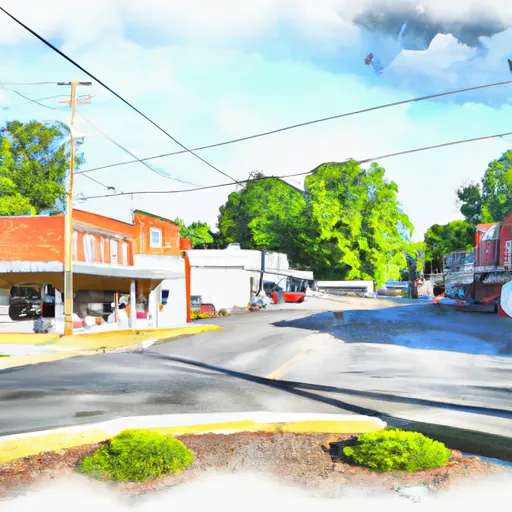-
 Snoflo Premium
Snoflo Premium
Get unlimited access to all our content
With no Ad interruptions! - Start Your Free Trial Login with existing account
Chavies
Eden Index
Climate
8.2
•
Recreation
3.4
•
Community
•
Safeguard
4.4/10

Chavies, Kentucky is a small community located in Perry County, in the eastern part of the state. The climate in Chavies is characterized by hot summers and cold winters, with an average annual temperature of 54°F. The area receives moderate rainfall throughout the year, with an average annual precipitation of 49 inches. The hydrology in Chavies is influenced by several streams and creeks, including the Middle Fork of the Kentucky River. This area is known for its abundance of outdoor recreation opportunities, including fishing, hunting, hiking, and camping. The nearby Buckhorn Lake State Resort Park is a popular destination for outdoor enthusiasts, offering a variety of recreational activities such as boating, swimming, and golfing.
What is the Eden Index?
The Snoflo Eden Index serves as a comprehensive rating system for regions, evaluating their desirability through a holistic assessment of climate health, outdoor recreation opportunities, and natural disaster risk, acknowledging the profound impact of these factors on livability and well-being.
Climate Health Indicator (CHI): 8.2
Chavies receives approximately
1186mm of rain per year,
with humidity levels near 85%
and air temperatures averaging around
13°C.
Chavies has a plant hardyness factor of
6, meaning
plants and agriculture in this region thrive during a short period during spring and early summer. Most
plants will die off during the colder winter months.
By considering the ideal temperature range, reliable water supplies, clean air, and stable seasonal rain or snowpacks, the Climate Health Indicator (CHI) underscores the significance of a healthy climate as the foundation for quality living.
A healthy climate is paramount for ensuring a high quality of life and livability in a region, fostering both physical well-being and environmental harmony. This can be characterized by ideal temperatures, reliable access to water supplies, clean air, and consistent seasonal rain or snowpacks.
Weather Forecast
Streamflow Conditions
Kentucky
Area Rivers
Kentucky
Snowpack Depths
Kentucky
Reservoir Storage Capacity
Kentucky
Groundwater Levels
Recreational Opportunity Index (ROI): 3.4
The Recreational Opportunity Index (ROI) recognizes the value of outdoor recreational options, such as parks, hiking trails, camping sites, and fishing spots, while acknowledging that climate plays a pivotal role in ensuring the comfort and consistency of these experiences.
Access to outdoor recreational opportunities, encompassing activities such as parks, hiking, camping, and fishing, is crucial for overall well-being, and the climate plays a pivotal role in enabling and enhancing these experiences, ensuring that individuals can engage in nature-based activities comfortably and consistently.
Camping Areas
| Campground | Campsites | Reservations | Toilets | Showers | Elevation |
|---|---|---|---|---|---|
| Douglas Dam Headwater | 65 | 1,037 ft | |||
| Panther Creek State Park | 50 | 1,192 ft | |||
| Sevier County Park - Douglas Reservoir | None | 1,073 ft | |||
| Smokemont - Smoky Mountains National Park | 142 | 2,242 ft | |||
| Balsam Mountain - Great Smoky Mountains | 43 | 5,328 ft | |||
| Cherokee Dam | 42 | 1,132 ft | |||
| Dandridge Municipal Park - Douglas Reservoir | None | 997 ft | |||
| May Springs | None | 1,103 ft | |||
| Douglas Dam Tailwater | 62 | 1,023 ft | |||
| Cosby - Great Smoky Mountains National Park | 165 | 2,430 ft |
Nearby Ski Areas
Catastrophe Safeguard Index (CSI):
The Catastrophe Safeguard Index (CSI) recognizes that natural disaster risk, encompassing floods, fires, hurricanes, and tornadoes, can drastically affect safety and the overall appeal of an area.
The level of natural disaster risk in a region significantly affects safety and the overall livability, with climate change amplifying these risks by potentially increasing the frequency and intensity of events like floods, fires, hurricanes, and tornadoes, thereby posing substantial challenges to community resilience and well-being.
Community Resilience Indicator (CRI):
The Community Resilience Indicator (CRI) recognizes that education, healthcare, and socioeconomics are crucial to the well-being of a region. The CRI acknowledges the profound impact of these elements on residents' overall quality of life. By evaluating educational resources, healthcare accessibility, and economic inclusivity, the index captures the essential aspects that contribute to a thriving community, fostering resident satisfaction, equity, and social cohesion.

